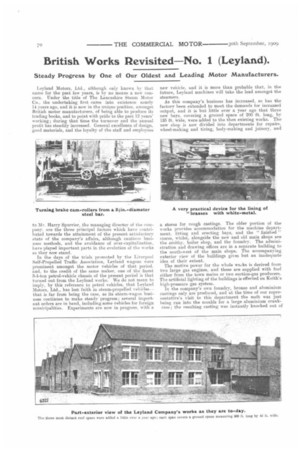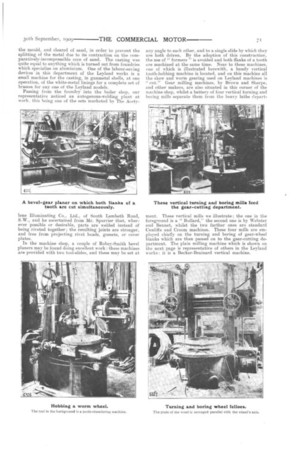British Works Revisited No. 1 (Leyland).
Page 4

Page 5

Page 6

If you've noticed an error in this article please click here to report it so we can fix it.
Steady Progress by One of Our Oldest and Leading Motor Manufacturers.
Leyland Motors, Ltd., although only known by that name for the past few years, is by no mewls a new concern. Under the title of The Lancashire Steam Motor Co., the undertaking first came into existence nearly 14 years ago, and it is now in the unique position, amongst British motor manufacturers, of being able to produce its trading books, and to point with pride to the past 12 years' working; during that time the turnover and the annual profit has steadily increased. General excellence of design, good materials, and the loyalty of the staff and employees to Mr. Harry Spurrier, the managing director of the company. are the three principal factors which have contributed towards the attainment of the present satisfactory state of the company's affairs, although cautious business methods, and the avoidance of over-capitalization, have played important parts in the evolution of the works as they now stand.
In the days of the trials promoted by the Liverpool Self-Propelled Traffic Association, Leyland wagons were prominent amongst the motor vehicles of that period. and, to the credit of the same maker, one of the finest 3-4-ton petrol-vehicle chassis of the present period is that turned out from the Leyland works. We do not mean to imply, by this reference to petrol vehicles, that Leyland Motors, Ltd., has lost faith in steam-propelled vehicles— that is far from being the case, as its steam-wagon business continues to make steady progress; several important orders are in hand, including some vehicles for foreign nmnicipalities. Experiments are now in progress. with a
new vehicle, and it is more than probable that, in the future, Leyland machines will take the lead amongst the steamers.
As this company's business has increased, so has the factory been extended to meet the demands for increased output, and it is but little over a year ago that three new hays, covering a ground space of 200 ft. long, by 135 ft. wide, were added to the then existing works. The new shop is now divided into departments for repairs, wheel-making and tiring, body-making and joinery, and a stores for rough castings. The older portion of the works provides accommodation for the machine department, fitting and erecting bays, and the " finished " stores, whilst, alongside the new and old main shops are the smithy, boiler shop, and the foundry. The administration and drawing offices are in a separate building to the south-west of the main shops. The accompanying exterior view of the buildings gives but an inadequate idea of their extent.
The motive power for the whole wo..ks is derived from two large gas engines, and these are supplied with fuel either from the town mains or two suction-gas producers. The artificial lighting of the buildings is effected on Keith's high-pressure gas system.
In the company's own foundry, bronze and aluminium castings only are produced, and at the time of our representative's visit to this department the melt was just being run into the moulds for a large aluminium crankcase; the resulting casting was instantly knocked out of
the mould, and cleared of sand, in order to prevent the splitting of the metal due to its contraction on the comparatively-incompressible core of sand. The casting was quite equal to anything which is turned out from foundries which specialize on aluminium. One of the labour-saving devices in this department of the Leyland works is a small machine for the casting, in gunmetal shells, at one operation, of the white-metal linings for a complete set of brasses for any one of the Leyland models. Passing from the foundry into the boiler shop, our representative noticed an autogenous-welding plant at work, this being one of the sets marketed by The Aeety lone Illuminating Co., Ltd., of south Lambeth Road, S.W., and he ascertained from Mr. Spurrier that, wherever possible or desirable, parts are welded instead of being riveted together ; the resulting joints are stronger, and free from projecting rivet heads, gussets, or cover plates.
In the machine shop, a couple of Robey-Smith bevel planers may be found doing excellent work : these machines are provided with two tool-slides, and these may be set at any angle to each other, and to a single slide by which they are both driven. By the adoption of this construction, the use of "formers "is avoided and both Wanks of a tooth are machined at the same time. Near to these machines, one of which is illustrated herewith, a handy vertical tooth-hobbing machine is located, and on this machine all the skew and worm gearing used on Leyland machines is "cut." Gear milling machines, by Brown and Sharpe, and other makers, are also situated in this corner of the maehine shop, whilst a battery of four vertical turning and boring mills separate them from the heavy lathe depart meat. These vertical mills we illustrate: the one in the foreground is a " Bullard," the second one is by Webster and Bennet, whilst the two farther ones are standard Curditle and Croom machines. These four mills are employed chiefly on the turning and boring of gear-wheel blanks which are then passed on to the gear-cutting department. The plain milling machine which is shown on the next page is representative of others in the Leyland works : it is a Becker-Brainard vertical machine. Amongst the machines used for the rapid production of " repetition " parts is a fine hexagon turret lathe by Alfred Herbert, a Potter-and-Johnson semi-automatic ma chine, and a large number of sturdy lathes by Dean. Smith and Grace, and Cunliffe and Cronin. We reproduce a photograph of a special crankshaft lathe built by the third-named maker, and this view shows the adjustable steadyrest; the use of this fixture is an absolute necessity when turning crankshafts out of Poldi steel, which is the material used for the crankshafts and gearshafts made hy the Leyland Company. These shafts, and all casehardened parts, are finally finished to gauge size on a Landis shaft grinder, or on one of the grinders by Brown and Sharpe and other makers, with which the machine shop is equipped. It has been found that the process of case-hardening causes some steels to expand, whilst others become slightly smaller in size as a result of the heat treatment, and due allowance for these characteristics most be made on the parts when they are " tooled."
In the wheel-making shop, side by side with a powerful hydraulic tiring press, a Webster and Bennet vertical turning and boring mill is installed, and this is capable of turning wheel felloes up to 40 in. in diameter. The Leyland Co.'s wheels are now made with the grain of the wood of which the felines are made'running parallel with the hub of the wheel instead of at right angles to it as is the usual practice of other makers. By the adoption of this arrangement of the wood's grain, the wheel may be pressed up to any degree of tightness without fear of the tire's becoming " felloe bound." All the Leyland wheels are now made on the composite system, of which method of construction this maker was the pioneer in the country. The hub, hollow spokes, and a light rim, are east all in one piece; well-seasoned ash or teak felines are then built up around the rim, and, after these are turned in the ver
tical mill which we illustrate, a steel rim is pressed over them. If rubber tires are to be fitted later, the pressedon steel rim is of quite a light section.
Several new vehicles were being assembled in the erecting department at the time of our representative's visit, and of these a new six-ton petrol-wagon chassis has many interesting points in its design. The engine, clutch and gearbox are practically the same as those fitted on the well-known Leyland four-tonner, but the double-reduction gearbox of the latter model's back axle has been modified, and it now rests on. and is securely bolted to, a very solid " dead " axle. This axle takes all the bending stresses due to the load, and the differential shafts in the doublereduction gearbox are thus freed of all but the torsional stress due to the final drive. The pressed-steel frame is 8 in. deep, and, in order to ensure easy springing, without making the chassis unduly high, the rear springs, which are 5 ft. long, are hung underneath the axle. The rear wheels are shod with Polack twin tires 41 in. in diameter by 51 in. wide. Another very practical vehicle which was then being erected was n four-ton timber wagon for Messrs. P. H. Haydock and Co., of Chorley. The chassis of this machine is a special one with 8 in. frame members and with the leading axle set hark about 18 in., and the driver's seat arranged above the engine and clutch. The setting-back
of the axle ensures a better distribution •of the imposed load, and the seating arrangement leads to a reduction of the overall length without unduly interfering with the free access to the engine and clutch. The length of the chassis behind the driver's seat is 16 ft. 6 in. Planks up to 20 ft. in length may thus be carried on the bolsters with an overhang not exceeding 3 ft. The overall length of the wagon is 2'2 ft., and its wheels are shod with largesection Shrewsbury and Challiner tires.
In the paint-shop, a smart two-tonner was being finished off for M. Pithridge and Son, Ltd., of Newcastle-on-Tyne : the vehicle, which will be employed in the wholesale provision trade, has one of the new, Leyland, 24 h.p., fourcylinder vertical engines fitted to it—this engine has the high-tension magneto and the centrifugal circulating-pump arranged transversely in front, of the cylinders, and driven by skew gearing from one of the camshafts. The final drive from the three-speed-and-reverse gearbox is to a worm-driven live hack axle. This is a very well-proportioned chassis and it is quite capable of dealing with an imposed load of from 2 to 21 tons; the overall length is 17 ft. 6 in., and, with a wheelbase of 10 ft. 6 in., the vehicle may easily be turned completely round, on either lock, in a roadway 36 ft. wide.
In conclusion, we would offer our sincere congratulations to Leyland Motors, Ltd., on the existence of the true vsprit de corps which is evident in all departments of the works at Leyland, and which feeling had its origin in Mr. Spurrier's two " outings " for the men in the year 1898, after the winning of two £100 prizes in the open competitions of the Liverpool Self-Propelled Traffic Association, and the Royal Agricultural Society of England.






















